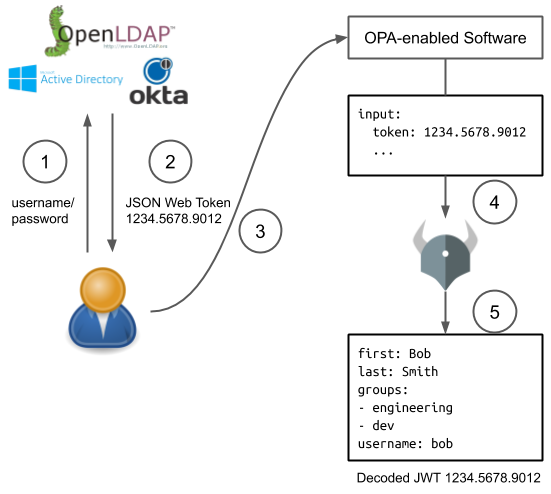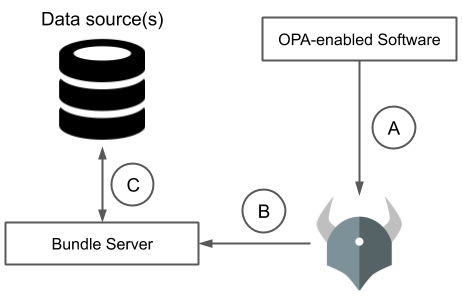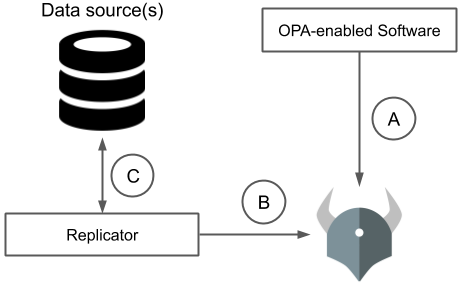OPA was designed to let you make context-aware authorization and policy decisions by injecting external data that describes what is happening in the world and then writing policy using that data. OPA has a cache or replica of that data, just as OPA has a cache/replica of policy; OPA is not designed to be the source of truth for either.
This document describes options for replicating data into OPA. The content of the data does not matter, but the size, frequency of update, and consistency constraints all do impact which kind of data replication to employ. You should prefer earlier options in the list to later options, but in the end the right choice depends on your situation.
Option 1: JWT Tokens
JSON Web Tokens (JWTs) allow you to securely transmit JSON data between software systems and are usually produced during the authentication process. You can set up authentication so that when the user logs in you create a JWT with that user’s attributes (or any other data as far as OPA is concerned). Then you hand that JWT to OPA and use OPA’s specialized support for JWTs to extract the information you need to make a policy decision.
Flow
The following diagram shows this process in more detail.
- User logs in to an authentication system, e.g. LDAP/AD/etc.
- The user is given a JWT token encoding group membership and other user attributes stored in LDAP/AD
- The user provides that JWT token to an OPA-enabled software system for authentication
- The OPA-enabled software system includes that token as part of the usual
inputto OPA. - OPA decodes the JWT token and uses the contents to make policy decisions.

Updates
The JWT only gets refreshed when the user authenticates; how often that happens is up to the TTL included in the token. When user-attribute information changes, those changes will not be seen by OPA until the user authenticates and gets a new JWT.
Size Limitations
JWTs have a limited size in practice, so if your organization has too many user attributes you may not be able to fit all the required information into a JWT.
Security
- OPA includes primitives to verify the signature of JWT tokens.
- OPA let’s you check the TTL.
- OPA has support for making HTTP requests during evaluation, which could be used to check if a JWT has been revoked. Though if you’re connecting to a remote system on every policy decision anyway, you should think about whether connecting to the authentication system directly is more appropriate (see below).
Option 2: Overload input
Often policies require external data that’s not available to the authentication system, ruling out JWTs. The calling system can include external data as part of input (necessitating of course that the policy is written accordingly).
For example, suppose your policy says that only a file’s owner may delete it. The authentication system does not track resource-ownership, but the system responsible for files certainly does.
The file-ownership system may be the one that is asking for an authorization decision from OPA. It already knows which file is being operated on and who the owner is, so it can hand OPA the file-owner as part of OPA’s input. This can be dangerous in that it ties the integration of OPA to the policy, but often it’s sufficient to have the file-ownership system hand over all the file’s metadata.
Flow
- OPA-enabled software gathers relevant metadata (and caches it for subsequent requests)
- OPA-enabled software sends
inputto OPA including the external data - Policy makes decisions based on external data included in
input

Updates
External data gets updated as frequently as the OPA-enabled software updates it. Often some of that data is local to the OPA-enabled software, and sometimes it is remote. The remote data is usually cached for performance and hence is as updated as the caching strategy allows.
Size Limitations
Size limitations are rarely a problem for OPA in this approach because it only sees the metadata for 1 request at a time. However, the cache of remote data that the OPA-enabled service creates will have a limit that the developer controls.
Security
This approach is as secure as the connection between the OPA-enabled service and OPA itself, under the assumption that the OPA-enabled service gathers the appropriate metadata securely. That is, using external data with this approach is as secure as using OPA in the first place.
Recommended usage: Local, Dynamic data
This approach is valuable when the data changes fairly frequently and/or when the cost of making decisions using stale data is high. It works especially well when the external data is local to the system asking for authorization decisions. It can work in the case of remote data as well, but there is more coupling of the system to OPA because the system is hardcoded to fetch the data needed by the policy (and only that data).
Option 3: Bundle API
When external data changes infrequently and can reasonably be stored in memory all at once, you can replicate that data in bulk via OPA’s bundle feature. The bundle feature periodically downloads policy bundles from a centralized server, which can include data as well as policy. Every time OPA gets updated policies, it gets updated data too. You must implement the bundle server and integrate your external data into the bundle server–OPA does NOT help with that–but once it is done, OPA will happily pull the data (and policies) out of your bundle server.
Flow
Three things happen independently with this kind of data integration.
- A. OPA-enabled software system asks OPA for policy decisions
- B. OPA downloads new policy bundles including external data
- C. Bundle server replicates data from source of truth

Updates
The lag between a data update and OPA having the update is the sum of the lag for an update between data replication and the central bundle server and the lag for an update between the central bundle server and OPA. So if data replication happens every 5 minutes, and OPA pulls a new bundle every 2 minutes, then the total maximum lag is 7 minutes.
Size limitations
OPA stores the entire datasource at once in memory. Obviously this can be a problem with large external data sets. Because the centralized server handles both policy and data it can prune data to just that which is needed for the policies.
Recommended usage: Static, Medium-sized data
This approach is more flexible than the JWT and input cases above because you can include an entirely new data source at the bundle server without changing the authentication service or the OPA-enabled service. You are also guaranteed that the policy and its corresponding data always arrive at the same time, making the policy-data consistency perfect.
The drawback is that the consistency of the data with the source of truth is worse than the input case and could be better or worse than the consistency for the JWT case (because JWTs only get updated on login). One feature currently under design is a delta-based bundle protocol, which could improve the data consistency model significantly by lowering the cost of frequent updates. But as it stands this approach is ideal when the data is relatively static and the data fits into memory.
Ecosystem Projects
Loading policy and data via Bundles is an important part of the OPA API. A number of ecosystem projects make use of this functionality to share code and keep data up-to-date. There are 4 projects which are listed in the OPA Ecosystem which use or work with Bundles.
Option 4: Push Data
Another way to replicate external data in its entirety into OPA is to use OPA’s API for injecting arbitrary JSON data. You can build a replicator that pulls information out of the external data source and pushes that information in OPA through its API. This approach is similar in most respects to the bundle API, except it lets you optimize for update latency and network traffic.
Flow
Three things happen independently with this kind of data replication.
- A. OPA-enabled software system asks OPA for policy decisions
- B. Data replicator pushes data into OPA
- C. Data replicator replicates data from source of truth
Depending on the replication scheme, B and C could be tied together so that every update the data replicator gets from the source of truth it pushes into OPA, but in general those could be decoupled depending on the desired network load, the changes in the data, and so on.

Updates
The total lag between the external data source being updated and OPA being updated is the sum of the lag for an update between the data source and the synchronizer plus the lag for an update between the synchronizer and OPA.
Size limitations
The entirety of the external data source is stored in memory, which can obviously be a problem with large external data sources. But unlike the bundle API, this approach does allow updates to data.
Recommended usage: Dynamic, Medium-sized data
This approach is very similar to the bundle approach except it updates the data stored in OPA with deltas instead of an entire snapshot at a time. Because the data is updated as deltas, this approach is well-suited for data that changes frequently. It assumes the data can fit entirely in memory and so is well-suited to small and medium-sized data sets.
Ecosystem Projects
Some OPA Ecosystem projects support pushing data into OPA. There are 2 projects listed in the OPA Ecosystem which implement push updates to OPA data.
Option 5: Pull Data during Evaluation
OPA includes functionality for reaching out to external servers during evaluation. This functionality handles those cases where there is too much data to synchronize into OPA, JWTs are ineffective, or policy requires information that must be as up to date as possible.
That functionality is implemented using built-in functions such as http.send. Check the docs for the latest instructions.
Current limitations
- Credentials needed for the external service can either be hardcoded into policy or pulled from the environment.
- The built-in functions do not implement any retry logic.
Flow
The key difference here is that every decision requires contacting the external data source. If that service or the network connection is slow or unavailable, OPA may not be able to return a decision.
- OPA-enabled service asks OPA for a decision
- During evaluation OPA asks the external data source for additional information

Updates
External data is perfectly fresh. There is no lag between an update to the external data and when OPA sees that update.
Size limitations
Only the data actually needed by the policy is pulled from the external data source. There is no need for a replicator to figure out what data the policy will need before execution.
Performance and Availability
Latency and availability of decision-making are dependent on the network. This approach may still be superior to running OPA on a remote server entirely because a local OPA can make some decisions without going over the network–those decisions that do not require information from the remote data server.
Recommended usage: Highly Dynamic or Large-sized data
If the data is too large to fit into memory, or it changes too frequently to cache it inside of OPA, the only real option is to fetch the data on demand. The input approach fetches data on demand as well, but puts the burden on the OPA-enabled service to fetch the necessary data (and to know what data is necessary).
The downside to pulling data on demand is reduced performance and availability because of the network, which can be mitigated via caching. In the input case, caching is under the control of the OPA-enabled service and can therefore be tailored to fit the properties of the data. In the http.send case, caching is largely under the control of the remote service that sets HTTP response headers to indicate how long the response can be cached for. It is crucial in this approach for the OPA-enabled service to handle the case when OPA returns no decision.
Ecosystem Projects
Loading data at evaluation time has been an area of focus for some projects in the OPA community.
There is currently 1 project
listed on the OPA Ecosystem page
which implements additional evaluation-time data sources.
Summary
| Approach | Perf/Avail | Limitations | Recommended Data |
|---|---|---|---|
| JWT | High | Updates only when user logs back in | User attributes |
| Input | High | Coupling between service and OPA | Local, dynamic |
| Bundle | High | Updates to policy/data at the same time. Size an issue. | Static, medium |
| Push | High | Control data refresh rate. Size an issue. | Dynamic, medium |
| Evaluation Pull | Dependent on network | Perfectly up to date. No size limit. | Dynamic or large |
Ecosystem Projects
Below are ecosystem projects related to External Data. Integrations are ordered by the amount of linked content.

Styra Declarative Authorization Service
Policy as Code Control Plane by Styra

Styra Enterprise OPA

OPAL
Open Policy Administration Layer by Permit.io

Open Policy Registry
A Docker-inspired workflow for OPA policies by Aserto
View these projects in the OPA Ecosystem.
Feedback
Was this page helpful?
Glad to hear it! Please tell us how we can improve.
Sorry to hear that. Please tell us how we can improve.
